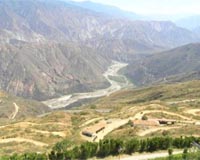| . |  |
. |
Boulder CO (SPX) Apr 15, 2010 China's tragic magnitude 6.9 earthquake on April 13 and the recent devastating earthquakes in Haiti, Chile, Mexico, and elsewhere have many wondering if this earthquake activity is unusual. Scientists say 2010 is not showing signs of unusually high earthquake activity. Since 1900, an average of 16 magnitude 7 or greater earthquakes - the size that seismologists define as major - have occurred worldwide each year. Some years have had as few as 6, as in 1986 and 1989, while 1943 had 32, with considerable variability from year to year. With six major earthquakes striking in the first four months of this year, 2010 is well within the normal range. Furthermore, from April 15, 2009, to April 14, 2010, there have been 18 major earthquakes, a number also well within the expected variation. "While the number of earthquakes is within the normal range, this does not diminish the fact that there has been extreme devastation and loss of life in heavily populated areas," said USGS Associate Coordinator for Earthquake Hazards Dr. Michael Blanpied. What will happen next? Aftershocks will continue in the regions around each of this year's major earthquakes sites. It is unlikely that any of these aftershocks will be larger than the earthquakes experienced so far, but structures damaged in the previous events could be further damaged and should be treated with caution. Beyond the ongoing aftershock sequences, earthquakes in recent months have not raised the likelihood of future major earthquakes; that likelihood has not decreased, either. Large earthquakes will continue to occur just as they have in the past. Though the recent earthquakes are not unusual, they are a stark reminder that earthquakes can produce disasters when they strike populated areas - especially areas where the buildings have not been designed to withstand strong shaking. What can you do to prepare? Scientists cannot predict the timing of specific earthquakes. However, families and communities can improve their safety and reduce their losses by taking actions to make their homes, places of work, schools and businesses as earthquake-safe as possible.
Share This Article With Planet Earth
Related Links Earthquake Hazards Program Web site Tectonic Science and News
 Andes Rise Was Gradual Not Abrupt
Andes Rise Was Gradual Not AbruptAnn Arbor MI (SPX) Apr 06, 2010 Trailing like a serpent's spine along the western coast of South America, the Andes are the world's longest continental mountain range and the highest range outside Asia, with an average elevation of 13,000 feet. The question of how quickly the mountains attained such heights has been a contentious one in geological circles, with some researchers claiming the central Andes rose abruptly to ... read more |
|
| The content herein, unless otherwise known to be public domain, are Copyright 1995-2010 - SpaceDaily. AFP and UPI Wire Stories are copyright Agence France-Presse and United Press International. ESA Portal Reports are copyright European Space Agency. All NASA sourced material is public domain. Additional copyrights may apply in whole or part to other bona fide parties. Advertising does not imply endorsement,agreement or approval of any opinions, statements or information provided by SpaceDaily on any Web page published or hosted by SpaceDaily. Privacy Statement |